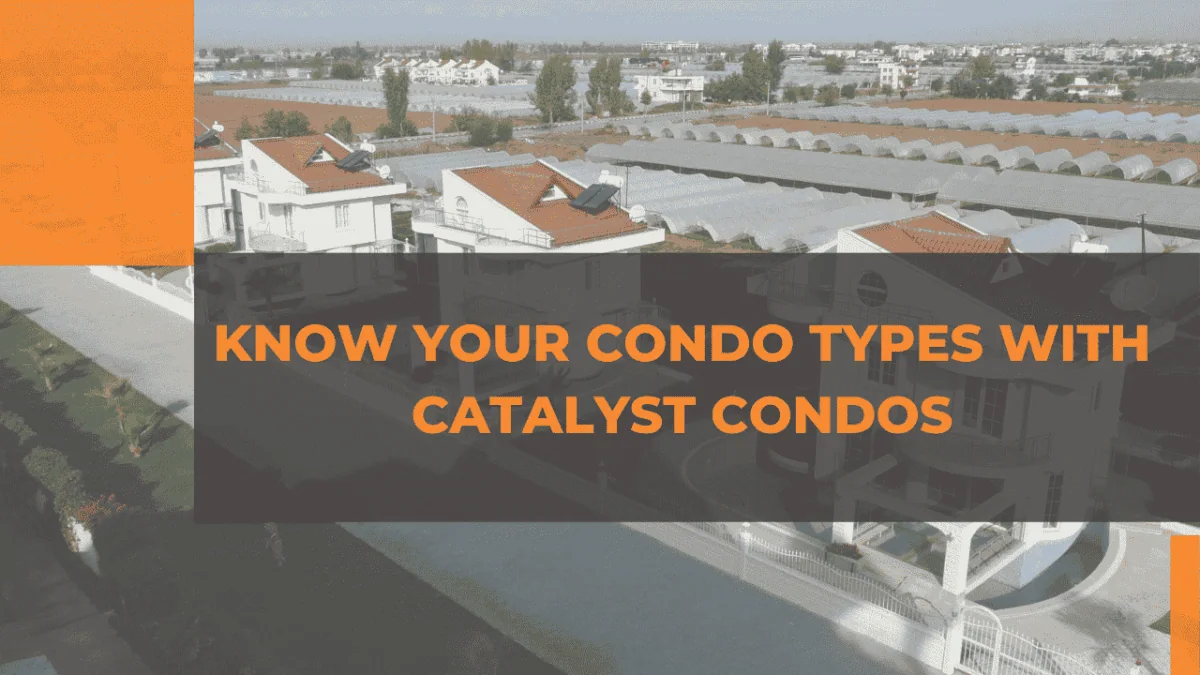Know Your Condo Types With Catalyst Condo Buying Guide
So, you know your condo types of buildings, do you? You’ve got some knowledge of the Condominium Property Act, you’ve got a sense of the business of condo corporations, and maybe you’re even up to snuff on the different factors that go into determining your condo fees. That’s all pretty impressive – but did you know there are different condos to learn and know about?
It’s true! While you might have thought that a condo is a condo, there are several different condo styles, configurations, and builds to know about – and we have a rundown of all of them right here in today’s blog.
High-Rises, Low-Rises, and Everything in Between
1. High-Rise Condo Types
When people think of condo living, they typically imagine life in a multi-story urban high-rise, complete with common spaces, amenities, and more. This type of condominium is known as a high-rise condo and is the configuration most often associated with the condo lifestyle as it’s generally understood.
High-rise condos benefit from offering appealing amenities in attractive, central urban locations. However, given their apartment-style configuration, high-rise condos often provide less living space than their counterparts tend to while leaning into the more close-quarters experiences associated with multi-person living. You’re almost guaranteed to share walls, floors, and ceilings with your fellow condo owners in a high-rise condominium – but that’s what the condo community is all about, right? A condo buying guide can help you navigate these unique aspects of condo living.
2. Low-Rise Condo Types
Low-rise condo buildings are often converted rental properties here in Alberta and can offer a more affordable alternative to their high-rise counterparts. However, you’re generally trading in low-rise condo living, foregoing prime urban locations and various amenities for a slightly simpler set-up and no-frills by nature.
If you’re looking to get into the condo lifestyle but don’t want to pay an arm and a leg in mortgage costs, amenity fees, parking expenses, and more, a low-rise condo might just be your best bet.
3. Loft-Style Condo Types
Now, this is where things start to get interesting.
Loft-style condos are unconventional by nature, often existing as converted spaces. These unique condominiums may have been warehouses, commercial buildings, or industrial complexes previously, but now exist as some of the coolest, trendiest places to call “home.” Of course, lofts can range wildly in cost, and you often give up typical condo amenities like pools, gyms, and the like by their very nature – but what you lose in little extras, you gain back exponentially in sheer cool factor as a result.
Loft-style condominiums aren’t suitable for everyone, but for those whose lifestyles fit the bill, a condo-buying guide can help determine if there’s no place better to be.
4. Townhouses and Rowhouses
If you were to press somebody to name alternate condo types aside from your conventional high-rise condominium, the townhouse-style condo is likely the eventual answer you’d receive.
Townhouse-style condos come in two different flavours: conventional and bare land offerings. A traditional townhouse condo is one in which the condo corporation looks after and maintains all exterior property as common property – although you’d do well to double-check with that community’s bylaws just by confirmation.
Alternatively, a bare land townhouse condo is one in which the owner enjoys land ownership up to the property’s boundaries. Depending on your outlook, this can be a boon or a burden. It’s a pro in that there’s a chance to own land in addition to property as a condo owner, and a con is that you have an outdoor property to look after on your own, just as if you were a typical single-dwelling homeowner. Different condo types come with varying levels of responsibility.
Some bare-land townhouse communities feature bylaws that call on the condo corporation to step in and lend a hand with repairs, upkeep, and the like. A condo buying guide can help you, check in on those bylaws to get a clear sense of just what’s required of you as a bare-land townhouse owner.
5. Detached Homes
“Wait a minute,” you might find yourself thinking. “Aren’t detached homes the exact opposite of what a condominium is?” Typically, you’d be right – detached single-dwelling homes are everything condos are not: stand-alone domiciles without the backing or support of an overarching community or condo board, which is a key difference from other condo types.
Every once in a while, however, detached homes will sneak their way into a larger condominium complex and be considered part of that community and condo corporation. On a larger scale, a gated community can also be an example of a condo complex that includes single-dwelling detached homes, with roadways, sidewalks, and recreational facilities acting as common property that the corporation would look after and maintain. These condo communities can include facilities as extravagant as tennis courts or full-blown golf courses as their featured amenities, showcasing just how flexible the condo corporation blueprint can be.
Did you learn a thing or two about new condo types today? Good on you – knowledge is power, after all! Interested in exploring an alternate type of condo to call home, or just keen to learn more about the differences between all the condominium varieties out there? A condo buying guide can be a great resource. Contact us at Catalyst Condo Management today, and we’ll happily chat about it!

